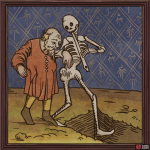Text
Evidence of burials is as old as mankind itself, but Christianity radically influenced all burial practices, and inextricably linked death with the need for church ritual and blessing. Before death, it was necessary to rid oneself of sins and to receive the last rites; in uncertain cases (such as going into battle), rituals were performed preventively.
The place of final rest was also important. It was considered best to be buried inside the church (walls, floor) or nearby, where cemeteries emerged. These cemeteries were an integral part of towns and villages and were often located in their centre. It was common for people to meet, trade and make contracts there.
The piety of cemeteries as we know it today did not exist - the dead and the living lived side by side. Only suicides, criminals, the sick, heretics, executioners, unknown strangers and unbaptized children were buried outside the cemetery, in unconsecrated ground.
During plague epidemics and wars, burials in cemeteries were temporarily abandoned and mass graves were used. In later centuries, for hygiene reasons and to avoid water contamination, most of the old cemeteries were abandoned, sometimes bodies were exhumed, and burial moved outside the city.
It was common for people to make at least an oral Will before dying. In the case of some property, at least part of it had to go to the Church for “mediating” the passage to the afterlife.
Burials were in plain wooden coffins or sacks, and the dead were dressed in shrouds. Costly and elaborate ceremonies were conducted at funerals of rich people and rulers. Royal funerals were attended by thousands of people. Wealthy families had stone tombstones made at their final resting places, the custom of building separate mausoleums came later.


No Comments